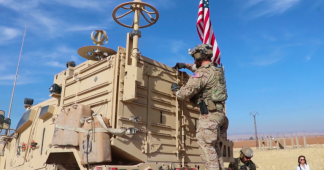By David Swanson
October 13, 2020
Photo: Housing on the Guantanamo base.
If, like me, you have the unfortunate habit of pointing out the dishonesty of the cases made for various wars, and you begin to persuade people that the wars are not actually for the eradication of the weapons of mass destruction that they proliferate, or the elimination of the terrorists that they generate, or the spreading of the democracy that they stifle, most people will soon ask “Well, then, what are the wars for?”
At this point, there are two common mistakes. One is to suppose there’s a single answer. The other is to suppose that the answers must all make rational sense. A basic response that I’ve given a gazillion times is that wars are for profit and power and pipelines, for control of fossil fuels and territories and governments, for electoral calculations, career advancement, and media ratings, payback for campaign “contributions,” for the inertia of the current system, and for an insane, sadistic lust for power and xenophobic malevolence.
We know that wars do not correlate with population density or resource scarcity or any of the factors used by some in U.S. academia to try to pin the blame for wars on their victims. We know that wars hardly overlap at all with the locations of the manufacture of weapons. We know that wars do correlate strongly with the presence of fossil fuels. But they correlate with something else as well that provides a different sort of answer to the question of what the wars are for: bases. I mean, we’ve all known for decades now that the latest U.S. permawars consist largely of coating various countries with bases, and that the goals include the maintenance of some number of permanent bases and over-sized embassy-fortresses. But what if the wars are not only motivated by the goal of new bases, but also driven in significant part by the existence of current bases?
In his new book, The United States of War, David Vine cites research by the U.S. Army showing that since the 1950s, a U.S. military presence has correlated with the U.S. military starting conflicts. Vine modifies a line from Field of Dreams to refer not to a baseball field but to bases: “If you build them, wars will come.” Vine also chronicles countless examples of wars begetting bases begetting wars begetting bases that not only beget yet more wars but also serve to justify the expense of more weapons and troops to fill the bases, while simultaneously producing blowback — all of which factors build momentum toward more wars.
Vine’s previous book was Base Nation: How U.S. Military Bases Abroad Harm America and the World. This one’s full title is The United States of War: A Global History of America’s Endless Conflicts, From Columbus to the Islamic State. It’s not, however, a detailed account of every U.S. war, which would require many thousands of pages. It’s also not a move away from the topic of bases. It’s a chronicle of the role bases have played and still play in the generation and conduct of wars.
There is, in the back of the book, a long list of U.S. wars, and of other conflicts that for some reason are not labeled wars. It’s a list that rolls on steadily from before the beginning of the United States to today, and that doesn’t pretend the wars against Native Americans didn’t exist or weren’t foreign wars. It’s a list that shows distant wars around the globe long-predating the completion of “manifest destiny” to the U.S. west coast, and shows small wars happening in numerous places at once and right through the occurrence of major wars elsewhere. It shows short wars and extremely long wars (such as a 36-year war against the Apache) that render obscene the constant announcements that the current war on Afghanistan is the longest U.S. war ever, and that render ridiculous the idea that the past 19 years of war is something new and different. While the Congressional Research Service once claimed the United States had been at peace for 11 years of its existence, other scholars say the correct number of peaceful years is zero thus far.
The mini-U.S. suburban paradises sprinkled across the globe as military bases are gated communities on steroids (and Apartheid). Their residents are often immune from criminal prosecution for their actions outside the gates, while the locals are only admitted within to do the yard work and cleaning. The travel and conveniences are great perks for military recruits and for budget-controlling Congress members touring base world. But the notion that the bases serve a protective purpose, that they do the opposite of what Eisenhower warned of, is just about upside down from reality. One of the main products of U.S. bases in other people’s countries is the bitter resentment that Vine reminds us pre-U.S. residents felt toward the British military occupation of North American colonies. Those British troops behaved lawlessly, and colonists registered just the sorts of complaints of looting, rape, and harassment that people who live near U.S. bases have been lodging for many decades now.
U.S. foreign bases, far from first sprouting up in 1898, were built by the budding new nation in Canada prior to the 1776 Declaration of Independence and grew rapidly from there. In the United States there are over 800 current or past military sites with the word “fort” in their names. They were military bases in foreign territory, as were countless other locations without “fort” in their current names. They preceded settler colonists. They provoked blowback. They generated wars. And those wars generated more bases, as the frontier was pushed ever outward. During the war for independence from Britain, as during most major wars that most people have heard of, the United States went right on waging numerous smaller wars, in this case against Native Americans in the Ohio Valley, western New York, and elsewhere. Where I live in Virginia, monuments and elementary schools and cities are named for people credited with expanding the U.S. empire (and Virginia’s empire) westward during the “American Revolution.”
Neither base construction nor war-making has ever let up. For the War of 1812, when the U.S. burned the Canadian Parliament, after which the British burned Washington, the U.S. built defensive bases around Washington, D.C., that did not serve their purpose remotely as well as most U.S. bases around the world do. The latter are designed for offense, not defense.
Read more at www.konstantakopoulos.gr











